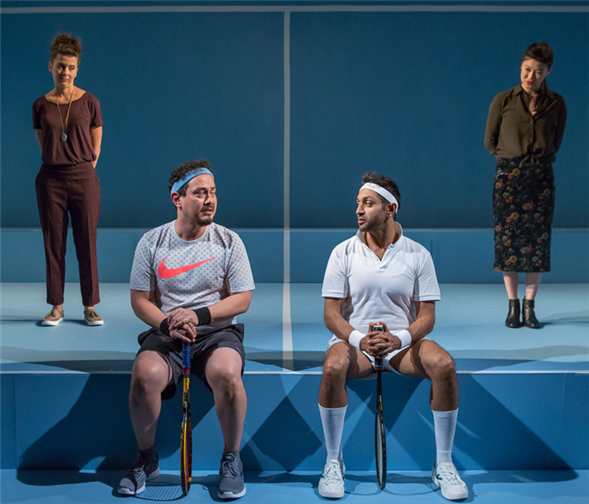Translate Page

The power of words in Andy Bragen's new comedy
---
It's amusing that Andy Bragen's latest play is called Don't You F**king Say a Word, since a clear way to understand the show is to notice who's talking. Words – who says them, and in what context – are the arbiter of power in this world, and anyone who keeps quiet is in trouble.
That's true from the very first scene in this vicious comedy, now playing at 59E59. Two women – Kate, a put-together businesswoman, and Leslie, her more disheveled friend – step on stage and announce they're going to "get inside" a fight their boyfriends had on a tennis court. That makes them all-powerful narrators, and they keep that power for two thirds of the show.
And sure, the women might bicker with each other about certain details, but there's no doubt they're in charge. The men, Brian and Russ, do exactly what the narrators describe, and when they're not enacting part of the story, they sit slumped on the floor, like marionettes waiting for someone to pull their strings.
It's hard to miss the implications about grown men who get so competitive over a tennis that they come to blows. "The men have no real understanding of the event itself," Bragen says. "Their inner eight year-old emerges, and they don't have any perspective on it. So in telling the story – which is loosely based on an incident that happened with me – I didn't really know how to approach it until the women offered a way into it. I wanted a little perspective and distance, and I wanted to explore more than just a fight on a tennis court. The women allowed a way into that."
{Image1}
The "narrator device" means even more when it starts to fall apart. The women eventually lose their control, and the result not only delivers a comedic climax, but also creates a major structural change. Again: If you notice who's talking from that point forward, then you have a sense of how things have shifted.
For Bragen, this structural element is crucial. "Form is the way into content right now," he says. "I think there's a burgeoning movement that's pushing against the way we understand content, and I think theatrical form is the way to tell a story that can't be told in other genres. It's a way to get at something deeper. So for me, how a play is built is really essential."
To that end, Bragen also uses language to build our visual sense of the play. Amy Rubin's straightforward set is an abstract tennis court, but thanks to the way people speak, we can picture the characters in dozens of locations.
Late in the show, for instance, we're told, "Here is where we are: a sunny, humid morning in late September 2011. New York City. Lower Manhattan. East River Park. It is the day of the match. Ten years ago, you could see the smoke from here. You could smell the ashes, the burning plastic. The city closed off all traffic below 14th Street. It was just for a week, but it felt longer. 13 months from now, these courts will be underwater. Hurricane Sandy. Zone A."
For many New Yorkers, those lines will conjure a hundred specific memories. "I want us to experience a larger place in the story by 'seeing with our ears,'" Bragen says. "I think there's a real theatricality in creating space with language."
---
TDF Members: At press time, discount tickets were available for 'Don't You F**king Say a Word.' Go here to browse our latest offers.
Follow Stages editor Mark Blankenship at @IAmBlankenship. Follow TDF at @TDFNYC.
Photos by Hunter Canning. Top photo (L to R): Jeanine Serrales, Michael Braun, Bhavesh Patel, and Jennifer Lim.